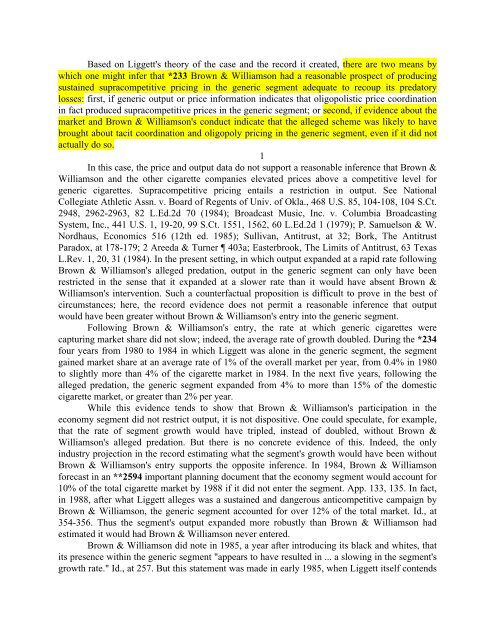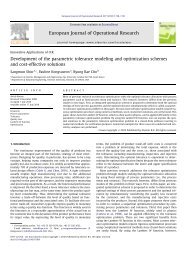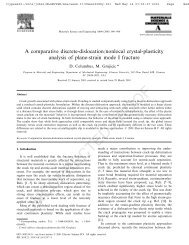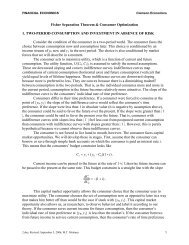509 U.S. 209, 113 S.Ct. 2578 BROOKE GROUP LTD., Petitioner v ...
509 U.S. 209, 113 S.Ct. 2578 BROOKE GROUP LTD., Petitioner v ...
509 U.S. 209, 113 S.Ct. 2578 BROOKE GROUP LTD., Petitioner v ...
You also want an ePaper? Increase the reach of your titles
YUMPU automatically turns print PDFs into web optimized ePapers that Google loves.
Based on Liggett's theory of the case and the record it created, there are two means by<br />
which one might infer that *233 Brown & Williamson had a reasonable prospect of producing<br />
sustained supracompetitive pricing in the generic segment adequate to recoup its predatory<br />
losses: first, if generic output or price information indicates that oligopolistic price coordination<br />
in fact produced supracompetitive prices in the generic segment; or second, if evidence about the<br />
market and Brown & Williamson's conduct indicate that the alleged scheme was likely to have<br />
brought about tacit coordination and oligopoly pricing in the generic segment, even if it did not<br />
actually do so.<br />
1<br />
In this case, the price and output data do not support a reasonable inference that Brown &<br />
Williamson and the other cigarette companies elevated prices above a competitive level for<br />
generic cigarettes. Supracompetitive pricing entails a restriction in output. See National<br />
Collegiate Athletic Assn. v. Board of Regents of Univ. of Okla., 468 U.S. 85, 104-108, 104 S.<strong>Ct</strong>.<br />
2948, 2962-2963, 82 L.Ed.2d 70 (1984); Broadcast Music, Inc. v. Columbia Broadcasting<br />
System, Inc., 441 U.S. 1, 19-20, 99 S.<strong>Ct</strong>. 1551, 1562, 60 L.Ed.2d 1 (1979); P. Samuelson & W.<br />
Nordhaus, Economics 516 (12th ed. 1985); Sullivan, Antitrust, at 32; Bork, The Antitrust<br />
Paradox, at 178-179; 2 Areeda & Turner 403a; Easterbrook, The Limits of Antitrust, 63 Texas<br />
L.Rev. 1, 20, 31 (1984). In the present setting, in which output expanded at a rapid rate following<br />
Brown & Williamson's alleged predation, output in the generic segment can only have been<br />
restricted in the sense that it expanded at a slower rate than it would have absent Brown &<br />
Williamson's intervention. Such a counterfactual proposition is difficult to prove in the best of<br />
circumstances; here, the record evidence does not permit a reasonable inference that output<br />
would have been greater without Brown & Williamson's entry into the generic segment.<br />
Following Brown & Williamson's entry, the rate at which generic cigarettes were<br />
capturing market share did not slow; indeed, the average rate of growth doubled. During the *234<br />
four years from 1980 to 1984 in which Liggett was alone in the generic segment, the segment<br />
gained market share at an average rate of 1% of the overall market per year, from 0.4% in 1980<br />
to slightly more than 4% of the cigarette market in 1984. In the next five years, following the<br />
alleged predation, the generic segment expanded from 4% to more than 15% of the domestic<br />
cigarette market, or greater than 2% per year.<br />
While this evidence tends to show that Brown & Williamson's participation in the<br />
economy segment did not restrict output, it is not dispositive. One could speculate, for example,<br />
that the rate of segment growth would have tripled, instead of doubled, without Brown &<br />
Williamson's alleged predation. But there is no concrete evidence of this. Indeed, the only<br />
industry projection in the record estimating what the segment's growth would have been without<br />
Brown & Williamson's entry supports the opposite inference. In 1984, Brown & Williamson<br />
forecast in an **2594 important planning document that the economy segment would account for<br />
10% of the total cigarette market by 1988 if it did not enter the segment. App. 133, 135. In fact,<br />
in 1988, after what Liggett alleges was a sustained and dangerous anticompetitive campaign by<br />
Brown & Williamson, the generic segment accounted for over 12% of the total market. Id., at<br />
354-356. Thus the segment's output expanded more robustly than Brown & Williamson had<br />
estimated it would had Brown & Williamson never entered.<br />
Brown & Williamson did note in 1985, a year after introducing its black and whites, that<br />
its presence within the generic segment "appears to have resulted in ... a slowing in the segment's<br />
growth rate." Id., at 257. But this statement was made in early 1985, when Liggett itself contends
















